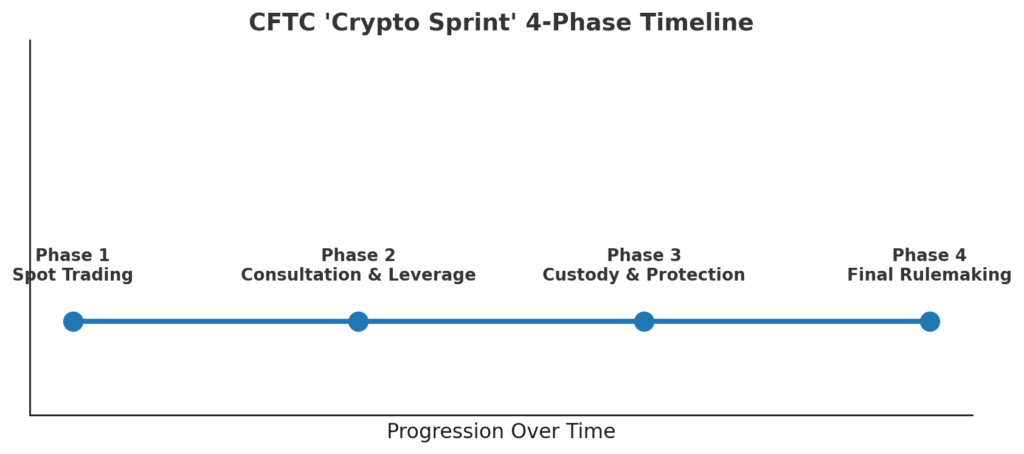
Main Points:
- CFTC launches its second phase of the “Crypto Sprint,” seeking public feedback and expanding rulemaking beyond spot trading.
- The effort aims to fully implement recommendations from the Trump-era President’s Working Group report on digital assets.
- Collaboration with the SEC’s Project Crypto deepens, targeting unified federal regulatory frameworks.
- Stakeholder engagement by October 20, 2025, will shape regulations around leveraged retail trading, custody, stablecoins, DeFi, and blockchain derivatives.
- This initiative positions the U.S. to lead global digital asset innovation amid internal CFTC staffing challenges and leadership uncertainty.
1. Introduction: From Phase One to Phase Two
The U.S. Commodity Futures Trading Commission (CFTC) has officially launched the second phase of its “Crypto Sprint” initiative, marking a significant escalation in its efforts to translate federal-level directives into actionable regulatory frameworks. Acting Chair Caroline D. Pham announced on August 21, 2025, that this new phase expands beyond the initial focus on enabling spot crypto trading on designated contract markets (DCMs), engaging in broader stakeholder consultations. The agency is now inviting input from market participants to help shape regulations around leveraged retail trading and beyond.
2. Background: Trump-Era Digital Asset Report and Initial Sprint
This initiative is rooted in the recommendations of the President’s Working Group on Digital Asset Markets, established during the Trump administration. The group’s 166‑page report proposed 18 recommendations to federal agencies—16 shared with multiple agencies and two specific to the CFTC. The key tasks for the CFTC include clarifying cryptocurrencies as commodities, defining registration requirements for DeFi projects, and establishing rules for blockchain-based derivatives.
In early August, the CFTC launched the first “Crypto Sprint” phase, focusing on enabling spot crypto asset trading on CFTC‑registered DCMs—addressing a long-standing regulatory grey area.
3. Phase Two: What’s New?
3.1 Expanding Consultation Scope
Phase two goes beyond enabling spot trading. The CFTC is now soliciting public feedback on all other recommendations in the digital asset report—particularly those involving leveraged, margined, or financed retail trading on CFTC-registered exchanges. Stakeholder input is welcomed through October 20, 2025. Submissions will be made public on CFTC.gov.
3.2 Collaborating with SEC’s Project Crypto
The CFTC continues to partner with the SEC, aligning its “Crypto Sprint” with the SEC’s “Project Crypto.” This joint effort aims to harmonize regulatory interpretation across agencies, clarify asset classifications (security vs. commodity), and establish unified licensing paths—potentially enabling super-app platforms offering combined services like staking, custody, and token issuance under one roof.
4. Broader Regulatory Landscape
4.1 Moving Toward Federal Legitimacy and Innovation
By institutionalizing spot trading and clarifying trading frameworks under federal law, the U.S. is setting the foundation for “federal legitimacy” in crypto markets. Observers see this as a shift from enforcement-first to innovation-first, fostering institutional participation and improving investor protection.
4.2 Internal CFTC Challenges
The CFTC is navigating this regulatory expansion amid staffing and leadership uncertainties. It currently operates with only two commissioners—Pham and Kristin N. Johnson—with leadership succession (Brian Quintenz’s nomination) still pending Senate approval. Addressing internal capacity constraints remains critical to executing these ambitious regulatory objectives.
5. Recent Developments in Blockchain Litigation and Legal Context
Alongside regulatory progress, recent legal developments shape the broader digital asset climate. Notably, the Second U.S. Circuit Court of Appeals vacated an insider-trading conviction related to NFTs, clarifying the definition of “property” under wire fraud statutes. This decision may influence how digital asset-related misconduct is prosecuted in the future.

graph or chart illustrating the four phases of the CFTC’s Crypto Sprint (Phase 1: spot trading; Phase 2: stakeholder feedback on leveraged trading; Phase 3: custody and consumer protections; Phase 4: final rulemaking), showing timeline and key topics.
6. Implications for Crypto Innovators, Investors, and Practitioners
- Institutional Legitimacy: Spot trading on federal exchanges adds trust and opens doors for institutional participation.
- Rule-Shaping Opportunity: Stakeholders can meaningfully influence regulation by submitting feedback by October 20.
- Market Clarity: Coordinated agency frameworks reduce uncertainty around asset classification, custody, and DeFi operations.
- Innovation Enablement: Regulatory clarity and harmonization could support blockchain-based financial products, stablecoins, and derivatives.
- Strategic Timing: With U.S. markets increasingly embracing regulated frameworks, early movers may secure strategic advantage.
7. Conclusion: Toward America Becoming Crypto Capital
CFTC’s second “Crypto Sprint” marks a pivotal moment in federal crypto policymaking. By expanding from enabling spot trading to consulting on leveraged retail trading, custody, and other operational domains, the CFTC—and its synergy with SEC—signals the U.S. is serious about becoming the global hub for regulated digital asset innovation. While internal agency limitations and leadership gaps pose challenges, the initiative embodies a shift toward a Golden Age of crypto innovation—one that market participants should actively engage to shape.

